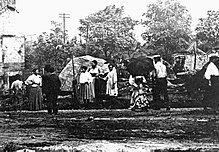This article contains too many or overly lengthy quotations. (November 2022) |
| 1908 Springfield Race Massacre | |
|---|---|
| Part of the Nadir of American race relations | |
 Burned black residences in "The Badlands" | |
| Location | Springfield, Illinois, US |
| Date | August 14–16, 1908 |
| Target | Black residents |
Attack type | |
| Weapons |
|
| Deaths | 17 (at least)
|
| Victims | 2,000 black refugees |
| Assailants | White mob |
No. of participants | est. 5,000 whites |
| Motive | |
| Convictions | 1 |
| Charges |
|
| Part of a series on the |
| Nadir of American race relations |
|---|
 |
The Springfield race riot of 1908 consisted of events of mass racial violence committed against African Americans by a mob of about 5,000 white Americans and European immigrants in Springfield, Illinois, between August 14 and 16, 1908. Two black men had been arrested as suspects in a rape, and attempted rape and murder. The alleged victims were two young white women and the father of one of them. When a mob seeking to lynch the men discovered the sheriff had transferred them out of the city, the whites furiously spread out to attack black neighborhoods, murdered black citizens on the streets, and destroyed black businesses and homes. The state militia was called out to quell the rioting.
The riot, trials and aftermath are said to be one of the most well-documented examples of the complex intersection of race, class, and criminal justice in the United States.[1][2] In 2008 an NPR report on the centenary of the race riot said that the fact of its taking place in a Northern state, specifically in "The Land of Lincoln", demonstrated that black people were mistreated across the country, not just in the South, and described the event as a proxy for the story of race in America.[3]
At least 17 people died as a result of the riot: nine black residents, and eight white residents who were associated with the mob, six of whom were killed by crossfire or state militias and two who died by suicide. It was misreported for decades that only militia were responsible for white deaths and that more whites than black people had died. Personal and property damages, suffered overwhelmingly by black people, amounted to more than $150,000 (approximately $4 million in 2018), as dozens of black homes and businesses were destroyed, as well as three white-owned businesses of suspected black sympathizers.[4][5][6]
As a result of the rioting, numerous black people left Springfield, but it is unclear how many moved away permanently. Although in the following months over 100 riot-related indictments were issued and some pleaded guilty to minor violations, only one alleged rioter went to trial and conviction for lesser offenses. Of the two accused black men, who were the initial focus of the lynch mob, one was eventually tried, convicted and hanged, the other was set free. Near the 100th anniversary in 2008, the City of Springfield erected historical markers and a memorial statue. The riot was a catalyst for the formation of the National Association for the Advancement of Colored People (NAACP), organized to work on civil rights for African Americans.[7]
- ^ Senechal de la Roche, Roberta (2008). In Lincoln's Shadow: the Springfield, Illinois, Race Riot of 1908. Southern Illinois University. p. 10.
- ^ "The So-Called Race Riot at Springfield, Illinois". Charities and the Commons. XX. New York, NY: 709–711. 1908.
- ^ Cheryl Corley (14 Aug 2008). "Springfield, Ill., Marks Centenary Of Riots". NPR.
- ^ "Mob Begins During After Negroes are Taken from Jail by Ruse: Woman Leads Rioters Who Wreck Big Restaurant; Nominee Chafin Protects Negro and Then is Stoned". St. Louis Post-Dispatch. St. Louis, Missouri. 15 Aug 1908.
- ^ "Springfield's Riot Bill". The Times-Democrat. New Orleans, Louisiana. 19 Sep 1908.
- ^ Himmick Becker, Helen (1975). "Becker, Helen - Interview and Memoir" (Interview). Interviewed by Kay MacLean. Oral History Collection, Archives/Special Collections, University of Illinois at Springfield.
- ^ "Oldest and Boldest". National Association for the Advancement of Colored People. Archived from the original on 2016-11-28. Retrieved 2018-02-28.
© MMXXIII Rich X Search. We shall prevail. All rights reserved. Rich X Search
